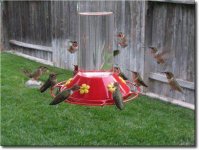suebeehoney
New member
I have seen videos that people have posted that shows their feeders with lots and lots of hummers feeding all together. Even my daughter has a couple that always have tons of birds on them. I have two hanging feeders and one window feeder. And the most birds I have seen at a time is just TWO on one if the feeders. I see a lot of hummers chasing off another one. Why do some people get tons of bummers feeding and I only get one who chases off any others? Am I doing something wrong, or is it just the luck of the draw, so to speak?





